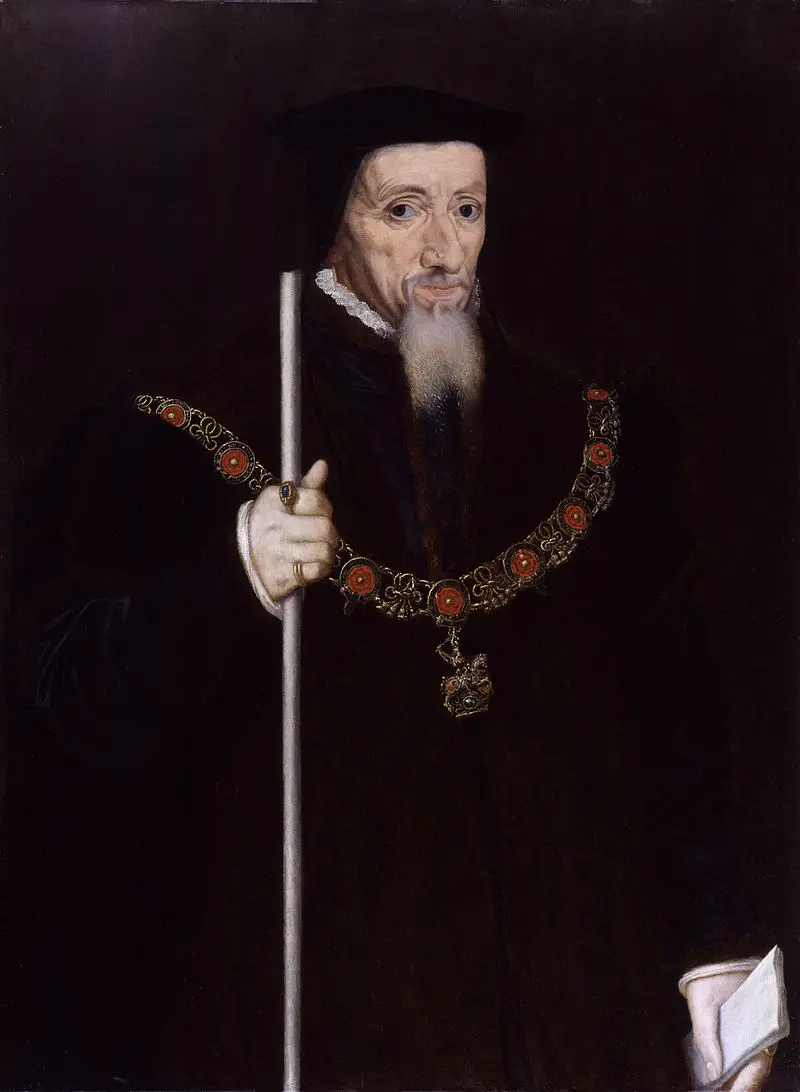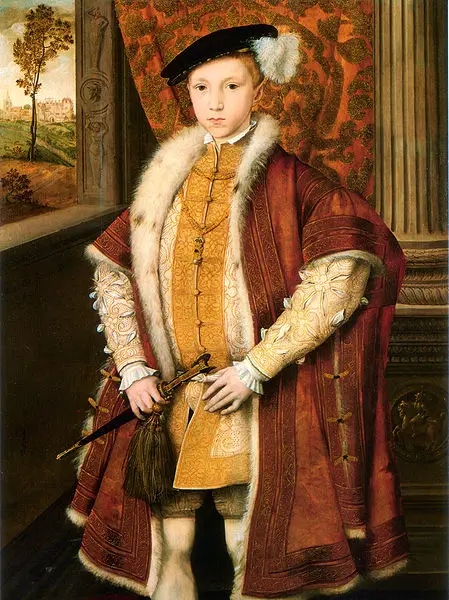On 20th February 1547, Shrove Sunday, King Edward VI was crowned king at Westminster Abbey.
Chronicler Charles Wriothesley recorded:
"The twentith daie of Februarie, being the Soundaie Quinquagesima, the Kinges Majestie Edward the Sixth, of the age of nyne yeares and three monthes, was crowned King of this realme of Englande, France, and Irelande, within the church of Westminster, with great honor and solemnitie, and a great feast keept that daie in Westminster Hall which was rychlie hanged, his Majestie sitting all dynner with his crowne on his head; and, after the second course served, Sir Edward Dymmocke, knight, came ridinge into the hall in clene white complete harneis, rychlie gilded, and his horse rychlie trapped, and cast his gauntlett to wage battell against all men that wold not take him for right King of this realme, and then the King dranke to him and gave him a cupp of golde; and after dynner the King made many knightes, and then he changed his apparell, and so rode from thence to Westminster Place."
John Gough Nichols, in Literary Remains of King Edward the Sixth, writes of how, at nine o'clock in the morning, Edward VI, accompanied by Edward Seymour, Lord Protector "and certayne other of his counsell and prevy chamber" was escorted by barge to Whitehall where he was conducted to the Court of Augmentations, which was "rychly hunge with clothe of Arras and a cloth of estate". There, he put on a robe of crimson velvet "with a long trayne, furred with powdred ermynes throughout" and a surcoat "of the same, furred with mynever pure, the coller, skyrtes, and sleeve-hands garnished with rybandes of golde, with ij. taberdes iiij. fingers brode, with a hode liekwyse powdred , which were called his parlement robes, wering on his hede a cappe of blacke velvett."
The King then processed to Westminster Abbey, with a long procession ahead of him, for the coronation ceremony. He walked under a canopy carried by the barons of the Cinque Ports behind the Lord Proector, who carried the crown, the Duke of Suffolk, who carried "the ball of golde, with the crosse", and the Marquess of Dorset, who carried the sceptre. Edward was flanked by the Earl of Shrewsbury and the Bishop of Durham, and followed by John Dudley, William Parr and Thomas Seymour, who all bore his train. Behind them processed the Gentlemen of the Privy Chamber, the nobility, the pensioners, the Captain of the Guard, the guard, and the court servants.
 A scaffold with stairs had been erected in the richly decorated abbey. On it was a throne decorated in "bawdekyn, damaske and gold", with two cushions, one of black velvet embroidered with gold and another of cloth of tissue, to help raise the small King. "The said chaire had ij. pillers, at the backe whereof there stood ij. lyons of gold, and in the middest a turret with a flowre de lyce [fleur de lys] of golde".
A scaffold with stairs had been erected in the richly decorated abbey. On it was a throne decorated in "bawdekyn, damaske and gold", with two cushions, one of black velvet embroidered with gold and another of cloth of tissue, to help raise the small King. "The said chaire had ij. pillers, at the backe whereof there stood ij. lyons of gold, and in the middest a turret with a flowre de lyce [fleur de lys] of golde".
The traditional coronation ceremony, used since 1375, had been adapted for the boy King. Instead of twelve hours, it would be seven. Thomas Cranmer, Archbishop of Canterbury, had also changed the coronation oath so that "reformation of the Church could now be enabled by royal prerogative, the king as lawmaker". The changes were explained in a sermon by Cranmer, who also likened Edward to the Biblical Josiah, and then the young king was anointed with "holy oyle and creme" before he was crowned with three crowns: the St Edward's crown, the imperial crown and a custom-made lighter crown. Trumpets blew between each crowning. The choir then sang a Te Deum and a ring of gold was set on the King's wedding finger. "Then sir Anthony Auger, master of the Jewell howse, brought the Kynges bracelettes of golde and precjous stones. Then dyvers other thynges was geyen to his Grace, as, - The earle of Shrewesbury delyvered the Kyng his scepter. The archebushope of Canterbury delyvered the Kyng St. Edwardes Staffe. The earle of Rutland delyvered the spurres. The duke of Suffolke delyvered the ball of golde. The earl of Oxford delyvered the regall of golde." Edward, sitting in St Edward's throne and crowned with the imperial crown, holding the orb, the sceptre, St Edward's staff and the spurs, then received the Lord Protector, Archbishop and nobles, who paid homage to him by kissing his left cheek.
Then there was mass and the King's offering before everyone processed back out of the abbey. The coronation ceremony was followed by a banquet in Westminster's Great Hall, more feasting and entertainment at Whitehall, and then two days of jousting and feasting. You can read all about the coronation banquet in Literary Remains, page ccxcvii onwards.
Trivia: Edward VI was the first monarch to be anointed as Supreme Head of the English Church.
Tudor Society members can read my article Edward VI's coronation - Primary Source Accounts and Archbishop Cranmer's speech, the July 2016 edition of "Tudor Life" magazine, which was an Edward VI special edition - click here to read it, and the Tudor Society Edward VI ebook.
Also on this day in history, in 1516, the baptism of Princess Mary, the future Mary I, in the Church of the Observant Friars at Greenwich. The princess was carried to the font by the Countess of Surrey, and her godparents were Catherine Courtenay, Countess of Devon and daughter of Edward IV; Margaret Pole, Countess of Salisbury and daughter of George, Duke of Clarence; the Duchess of Norfolk and Cardinal Thomas Wolsey.
Notes and Sources
Images: Westminster Abbey, copyright Tim Ridgway.
- Wriothesley, Charles (1875) A Chronicle of England During the Reigns of the Tudors from AD 1485-1559, Volume 1, p182-183.
- Nichols, John Gough (1857) Literary Remains of King Edward the Sixth, Roxburghe Club, p. ccxciv to ccxcvii, at https://archive.org/stream/literaryremains00clubgoog#page/n325/mode/2up





I can’t believe how much little Edward looked like his father! It really is uncanny.
I love those contemporary descriptions, of the clothes, the ceremony, the location. It makes it almost as real as though you had been there yourself. Thanks to the chroniclers and letter writing enthusiasts of that era!
The Coronation speech by Archbishop Cranmer is a fabrication; a forgery from the Stuart period. See “All Things Made New” by Diarmaid MacCulloch (2016), a collection of Reformation essays of high scholarship, as one would expect from this historian. [Chapter 21 “Forging reformation History; a Cautionary Tale”]